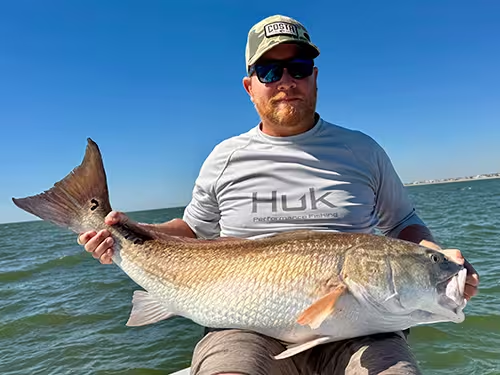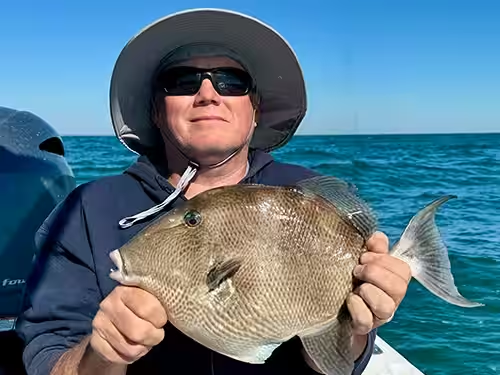
October in Ocean Isle Beach is bull red season — the one time of year when everything aligns just right. Clear skies, light winds, cool mornings, and powerful outgoing tides push bait through Shallotte Inlet, and when that happens, the big drum follow.
This trip was one of those special days where everything came together. I want to take you along for the ride — to show you exactly how we fished, when we fished, where we positioned, and how the plan came together from first bait drop to final release.
On October 23, 2025, we launched out of the Ocean Isle Beach ramp and set up just outside Shallotte Inlet — a familiar stretch of sandbars and troughs that’s been producing trophy redfish for years.
Conditions, Tides, and Setup for Bull Redfish in OIB
Bull Drum feed hardest when the outgoing tide pulls fresh bait from inlets into deeper channels and troughs.
The tide peaked a couple hours before we met. We met near the Ocean Isle Beach Bridge, then headed east on the ICW towards Shallotte Inlet, and started fishing about 15 minutes later with clean, green water, light chop, and a gentle southwest breeze. The surface temp held steady near 70°F — textbook conditions for bull reds staging off the inlet.
Our starting spot sat along the west edge of Shallotte Inlet, on the ocean side, where depth dropped from 12 to 15 feet. The key was spot-locking bow-into-current right along that slope — where moving water met structure.
Bait was simple and fresh: peanut pogies and mullet I’d cast-netted near the Ocean Isle Beach Bridge the evening before. We cut them into chunks, removed tails for scent, and set out four rods with 4 oz egg sinkers, 7/0 circle hooks, and 40 lb fluorocarbon leaders.
Bull Redfish Gear and Rigging Setup
Medium to heavy fishing gear shortens the fight and keeps big drum healthy for release.
- Rods/Reels: PENN Spinfisher VI 5500 on TFO Tactical Inshore 7’–7’6” rods.
- Main Line: 30 lb PowerPro braid.
- Leader: 40 lb Seaguar fluorocarbon.
- Hook/Sinker: 7/0 VMC circle hook on a knocker rig with a 4 oz egg sinker.
The knocker rig keeps the bait pinned near bottom while letting the redfish inhale it without feeling weight — perfect for these deep, sandy channels.
The First Bite Zone — Outgoing Tide Bull Redfish Action

It's been my experience that Bull Reds feed most aggressively two to four hours after high tide — when bait is flushed from the inlet into deeper water.
Within about 20 minutes of setting up, the falling tide was rolling, and the first rod doubled over. Over the next two hours, we landed six bull reds between 36 and 42 inches — all caught within a few boat lengths of that initial starting point along the west edge of the inlet.
Early bites came on fresh-cut pogies, but as the current slowed, mullet heads outperformed everything else. That bait stays put and keeps pumping scent through the water — a difference-maker once the tide’s halfway out.
This stretch, where contour and current meet, is what I call the “First Bite Zone.” It’s a short window — but when it’s right, it’s electric.
The Deep Bite Zone — Targeting Late-Tide Bull Reds
As the current slows, I like to reposition the boat deeper to stay connected to the school.
When the outgoing tide began to fade, I repositioned slightly deeper to about 20 feet, staying aligned with the same western contour. We set up, baited fresh mullet heads, and waited.
About 15 minutes later, one last rod bent over, producing a solid 40-inch bull redfish. It was the final push before slack — proof that patience and small adjustments can extend your bite window.
Bonus Action at Jolly Mon Reef

After the tide bottomed out, I knew that the Bull Drum bite was going to slow down, or stop altogether. I gave my clients the option to finish out their charter bottom fishing for other species. They agreed and we made a short 10-minute run to Jolly Mon Reef (AR-460) to round out the day.
We switched to Penn Battle III 3000 combos with 30 lb braid, and chicken rigs tied with 100 pound mono, 4/0 circle hooks, and 2 ounce bank sinkers. We used the same pogies we used earlier in the day while fishing for Bull Reds.
The shift in depth and structure turned up a mixed bag of flounder, triggerfish, and black sea bass — the perfect way to end a classic fall charter.
Safe Handling and Catch-and-Release for Bull Red Drum
Bull reds are all breeders — every release matters. We fight them quickly on stout gear, keep them in the water until photos are ready, and support their bellies horizontally.
ALWAYS revive Bull Drum before releasing, as shown in the video here, where Captain Harvey revives a Bull Drum before release. The process is simple—just hold them by the tail, move them gently back and forth through the water to force water over their gills. Once revived, they’ll swim away strong on their own.
Proper Bull Red Drum Release Techniques
- Use circle hooks to minimize fish mortality.
- Always use a landing net.
- Wet your hands before touching the fish to protect their slime coat.
- Keep the fish in the water as much as possible while removing hooks or taking photos.
- Never hold bull reds by the jaw, gills, or lift them vertically by the mouth — always support them horizontally.
- Avoid placing fingers in their eyes.
- Have your camera out and ready, and tell whoever’s taking the photo where to stand before lifting the fish. The fish can stay in the net and in the water while you get set up.
- Revive the fish in calm water before release by holding it upright by the tail and moving water over its gills.
Note: Captain Harvey recently saw a photo from one of the NC piers showing a bull red being held by someone sticking their fingers in its eye sockets. Never do that to a fish you're going to release!
Bull Redfish Patterns, Tides, and Takeaways
October in Ocean Isle Beach delivers some of the most consistent trophy drum action in North Carolina. Watch the tides, fish the slopes, and use fresh-cut bait on rigs that let your offering move naturally with the current.
For a deeper dive into how I target redfish in local waters, visit my Ocean Isle Beach Redfish Guide.
Want to see how we're catching reds this Winter? Read my Winter Redfish Fishing in NC blog to see how patterns shift as the water cools.
Book Your Ocean Isle Beach Bull Redfish Charter
Every October, these big drum pile into our inlets and nearshore waters — and I’ve spent years dialing in the where, when, and how. When you book a bull red charter with me, you’ll be fishing with proven rigs, fresh bait, and techniques that consistently produce trophy-class reds.
Want in on next season’s action? My 2026 bull red calendar is now open for October bookings — lock in your dates early! BOOK MY BULL RED CHARTER ONLINE or call / text Captain Harvey 910.250.8459 to reserve your spot.
FAQs — Bull Red Drum Fishing in North Carolina
What tide is best for bull redfish in North Carolina?
Bull reds feed best during the outgoing tide — especially two to four hours after high tide — when baitfish are flushed out of inlets into deeper channels and troughs.
What bait works best for bull reds in Ocean Isle Beach?
Fresh-cut pogies and mullet are hard to beat. Use the head section during slower current and mid-body chunks when water is moving fast.
Can you keep bull red drum in North Carolina?
No. Trophy-size “bull” red drum are protected. Anglers can keep one redfish between 18–27 inches per day. All larger fish must be released immediately. Learn more at NC Wildlife Commission Red Drum Regulations.
Is the Lupton rig good for bull redfish?
Yes. The Lupton rig is a popular option for anglers who want to ensure clean releases. It uses a short leader and fixed sinker to keep the bait tight to bottom, helping prevent deep-hooking. While I prefer the knocker rig for our sandy-bottom inlets, the Lupton rig is a great choice where required or when conservation is your top priority.
What’s the world record bull redfish?
The world record red drum weighed 94 pounds, 2 ounces, caught by David Deuel in 1984 along the North Carolina coast. It remains both the IGFA All-Tackle World Record and the North Carolina state record over forty years later. Learn more about the catch and its history on my blog: North Carolina World Record Red Drum — 94 lbs 2 oz (1984).

Tight Lines,
Captain Harvey Wall
Salty Dawg Fishing Charters
Updated: November 10, 2025